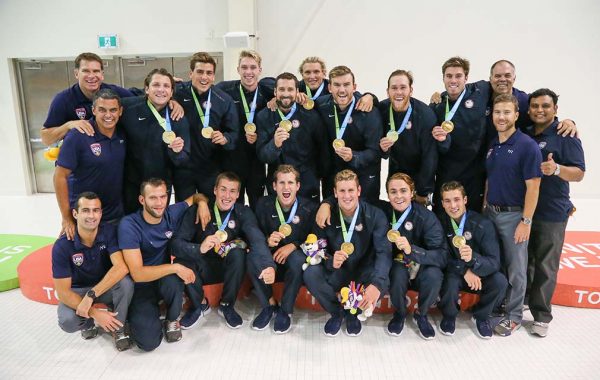
Naresh Rao (far right) ’93, head physician for Men’s USA Water Polo, with the team when they qualified for Rio 2016 Summer Olympics by winning gold at the PanAm Games
Naresh Rao ’93
I’ve always thought of myself as an athlete. I played competitive football, basketball, and tennis in high school. At Colgate, I was a member of the water polo club, which was started by my close friends Craig Pizer ’93 and Matt Kaplan ’93. It was the hardest sport I had ever played, and it transformed my mind and my body. The discipline I adopted carried over to the classroom, lab, and medical school. I decided to study osteopathic medicine because I was attracted to its approach of taking the whole person into account: physical, emotional, and spiritual.
Now, as a primary care sports medicine specialist, I have married my two interests. Over the past 15 years, I have treated hundreds of elite athletes and a full range of weekend warriors. In my new book, Step Up Your Game, I outline a holistic program for improving one’s athletic performance, based upon programs such as those used by Olympic athletes. So, whether you’re a recreational golfer or training for your next marathon, here are some tips to help you step up your game.
Ice vs. heat for treating pain. I use them for different applications. My rule of thumb is: After an acute injury, use ice for 20 minutes on the hour, along with elevation and compression (e.g., an Ace bandage), for the first 24 to 48 hours. This is part of the RICE method: Rest, Ice, Compression, Elevation. The ice is thought to reduce inflammation and pain. I use heat for chronic muscular tension or spasm. Moist heat will help muscles relax; a hot shower can be very effective.
The importance of stretching. If a muscle is not properly stretched after a workout, it may not function optimally, and you may be more likely to injure it. One trick doctors of osteopathic medicine teach is muscle energy. For each stretch, bring the muscle into a full stretch, but not to the point of pain. Then, while holding the stretch and using a low level of force (less than 25 percent of your maximum), tighten the muscle for five seconds. Relax for three seconds; repeat three times. Afterward, stretch again, but this time without contraction, holding for 10 seconds.
Essential eating. Maintaining the right macronutrient ratio is the secret to providing the energy to match the performance that you want. For example, if you are having a hard time gaining muscle, you may not be eating enough protein. However, there’s more than just protein. I focus on following an anti-inflammatory diet: fresh vegetables and fruits, whole grains, and fats like olive oil, flaxseed oil, and avocados, as well as nuts, while limiting processed foods, refined sugars, artificial ingredients, and foods that contain trans fats. When selecting animal protein, choose fish, poultry, low-fat beef or lamb, and omega-3 eggs. Also make sure you are getting enough water. Base your consumption on thirst, and the color of your urine. When you are well hydrated, your urine will be pale, almost colorless.
Mindfulness. One of the most effective tools sports psychologists teach is the practice of clearing our thoughts of everything besides the present moment. This involves learning how to simply and nonjudgmentally observe your own breath, body, or thoughts. By focusing on the here and now, mindfulness can train you to stay on task and avoid distraction; it can also improve memory, decrease stress, and increase overall happiness. A formal practice consists of structured experiences like mindful meditation.
— Naresh Rao ’93






